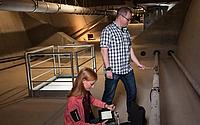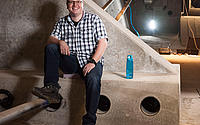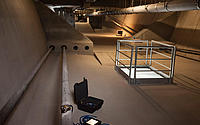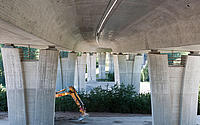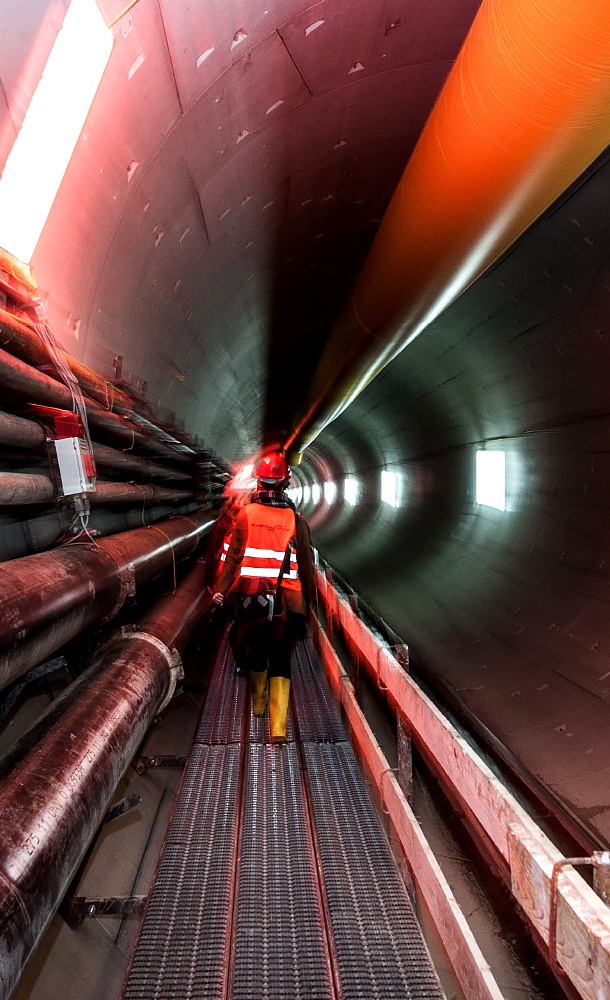How Steffen Siegel wants to ensure safety under bridges and other rope-tensioned structures.
Traffic on the A8 between Karlsruhe and Pforzheim to Stuttgart thunders over the Pfinztal Bridge near Noettingen - a well-traveled route, notorious for its construction sites and traffic jams. It is noisy on the bridge, but the noise seems even more booming below the roadway, inside the bridge. "You get used to it," laughs KIT scientist Steffen Siegel, who has his field of work here, in the hollow box of the bridge. While forty-ton trucks whiz by a few meters above his head, he measures whether the bridge's wire ropes are still intact in just a few steps.
According to the Federal Ministry of Transport, there are 39,000 bridges in the network of highways and federal roads, of which an estimated 15 percent would need renovations. Either because there are actual technical defects or because they are so old that they are not designed for today's traffic loads. Many of these bridges are cable-stayed bridge systems, which include suspension bridges such as the famous Golden Gate Bridge in San Francisco. More often, however, the wire cables are not visible at all - as is the case with the Pfinztal Bridge, opened in 2014, whose wire cables internally hold the structure together. These so-called external tendons run in the box girder along the entire length of the bridge, sometimes in a straight line, sometimes in a zigzag pattern, from one end of the bridge to the other.
The wire ropes used must withstand enormous loads. In Germany, there are seven approved types of external tendons for cable-stayed structures, the geometrical arrangement of which differs but they have some characteristics in common: They consist of several thin steel cables twisted into a thicker strand. Many of these strands form a tendon and hold together by one or two plastic jackets. If moisture enters the rope through a crack in the material, for example, more and more of the thin initial ropes will rust and break.
Today's measuring methods allow the detection of defects either only at a level at which the complete rope needs to be replaced, i.e. when the bridge is already badly in need of rehabilitation. Alternatively, renovations are so time-consuming and therefore cost-intensive that regular use of these methods is not economically viable. This leads to the dreaded full closures on freeways and highways, because bridges that are at high risk may no longer be driven on. This problem costs the federal and state governments a lot of money.
"Structural inspection on cable-stayed bridges is extremely complex. A comprehensive main inspection takes place every six years, with regular inspections every one to three years. With the volume of bridges and the pressure not to interfere with flowing traffic, inspectors cannot completely disassemble every bridge. They cannot simply look into the wire ropes," explains bridge expert Steffen Siegel from KIT Institute for Solid Construction and Building Materials Technology. A few years ago, he came up with the idea of measuring the bridge cables from the outside in a non-destructive way, without any time-consuming intervention in the technology. ResoCable® is the name of the measuring system developed by Siegel, which he is now developing to market maturity together with the companies ZINS Ziegler-Instruments GmbH and Breinlinger Ingenieure Hoch- und Tiefbau GmbH: "Our product works on the basis of a dynamic vibration measurement with tension force determination. You can think of it as a 'virtual tuning' of a stringed instrument," explains the scientist. He uses a small rubber mallet to make the wire ropes vibrate. A sensor attached to the wire rope with magnets serves as a vibration transducer and records the vibrations of the rope, which are used to determine its natural frequencies.
By means of a patent-pending analysis of the frequencies at different points on the bridge and at different times, which is mapped in software, wire breaks can be read out immediately at the measuring point, says Steffen Siegel: "We take an initial measured value as the starting value. If we measure again after three years, for example, and the value has changed significantly, we know that the wire has been damaged." Compared to before, damage is thus detected very early and bridge rehabilitation can be planned in advance. The method is fast and inexpensive; inspectors receive the meaningful results directly on site. Together with the cooperation company, Siegel is now working on setting up a central database to document the results.
This is intended to ensure that the barcode-marked measuring points of a structure exist only once worldwide and that no mix-ups of structures creep in. "This is not a problem in Germany; we have a clear naming structure for engineering structures here. But we have to make sure that the system can be used worldwide and that an inspector can still rely on entering and evaluating the data of the correct structure," explains Steffen Siegel. Even though the cooperation partners are currently working on optimizing the technology, it is already functioning in practical use. For example, the measuring device was used for a successful inspection of all bridges in the Stuttgart area.
"If ResoCable® was used across the board, it would save a lot of money in the transportation sector in the long term," says Siegel. However, not only there: The measurement method is suitable for all cable-tensioned structures. This also includes wind turbines and sports stadiums, such as the RheinEnergie Stadium in Cologne, on whose cable-tensioned roof Steffen Siegel has already measured. The use of a fast method such as ResoCable® would be particularly interesting for the main inspections in large wind farms. In any case, the measurement of the Pfinztal bridge was successful - as expected, it is still intact, recognizes Steffen Siegel: "We are curious when we will detect the first damage."
"We have a functioning product that creates real added value in the maintenance of large structures. Now it is a matter of convincing at the political level, too, that standard use makes sense. It would simply be a shame if this technology disappeared back into the drawer."
Award for ResoCable®
The initiative "Germany - Land of Ideas" and Deutsche Bank award prizes in the competition "Excellent Landmarks in the Land of Ideas" to projects that have a lighthouse character for Germany as a business location. With last year's theme "City, country, network! Innovations for a digital world", ideas were sought that make a positive contribution to shaping a networked world and provide answers to the challenges of digital transformation. ResoCable® was honored in October 2015 as one of the "100 excellent places".
Images: KIT


